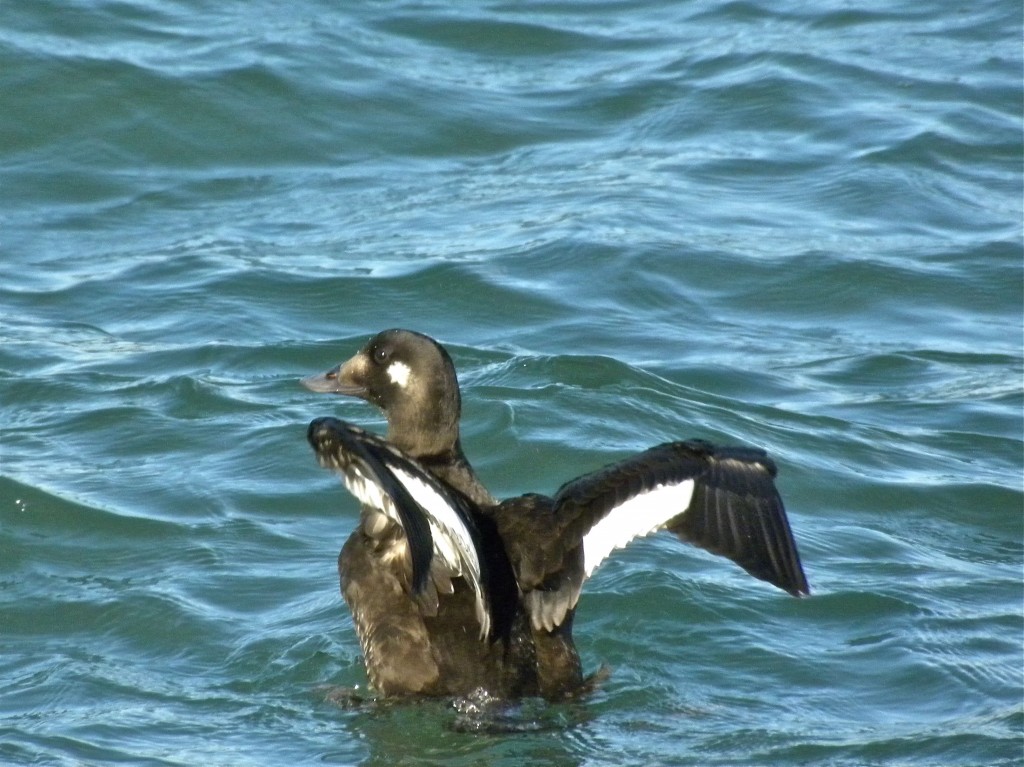December 1 2012. Burlington ON. Heading home after a morning spent watching over crowds of children of all ages enjoying a spectacular model train show put on especially for the Christmas season, I needed a dose of bird-time. So I made a detour to a popular boaters’ and birders’ hangout, a marina for six months of the year, on the shore of the bay.
Our winters are usually deeply cold, cold enough that the pressure of ice around moored boats could crush the hulls. Every October the boats are lifted out of the lake and stored high and dry in fenced compounds, a process and expense that must surely sort out the sailors who are either really serious or have ample financial resources; probably both, from the mere dreamers. So at this time of year, marinas around the Great Lakes are largely empty except for fisherman, dog-walkers and birds and their admirers.
Winter usually brings in a varied collection of waterfowl to the bay, sometimes a rarity shows up, as did a young Common Eider last winter and a Barrows Goldeneye a decade or so ago; it’s usually an interesting stop, sometimes only for a quick leg-stretch.
Today I enjoyed several Trumpeter Swans mixing in with American Coots and Red–breasted Mergansers. A bit farther offshore a raft of Rudy Ducks bobbed like a line of linked marker buoys together with Lesser Scaups and a few Common Goldeneyes. Then my attention was grabbed by a Black Scoter, its flattened shovel-like bill a striking pale orange like an egg yolk in vivid contrast to its coal black body and head.
Much farther out were a few more Black Scoters and also many White–winged Scoters. At the distance involved the White-winged were distinguishable only by the flash of white at their wingtips. Between them they made the stop worthwhile, scoters were my instant Bird of the Day.

[slickr-flickr tag=”lakescoter”]
The word ‘scoter’ according to my bird names reference, is probably a variant of the word coot; to which they have a superficial similarity. There are three scoter species, only the Surf Scoter was not seen today, but all of them are rather large, very dark brown to jet black, somewhat lumpy looking ducks. The distinguishing field marks are fairly easily grasped, but in a pinch can be distilled to: the Black Scoter is black, the White-winged Scoter has white in its wings and the Surf Scoter isn’t quite the same as either of the others. Females are different again, lots of brown tones; difficult birds! All breed in Arctic waters but arrive to winter on Lake Ontario, mostly White-winged Scoters, in their hundreds of thousands in November and December. It wasn’t always that way, their fairly recent arrival here is linked to the abundance of Zebra Mussels that have invaded the Great Lakes in the last couple of decades. The mussels are a seemingly inexhaustible supply of high protein food easily plucked off the bottom by diving ducks like scoters, goldeneyes, Long-tailed Ducks, scaup and Buffleheads. They have transformed winter birding on this lake.